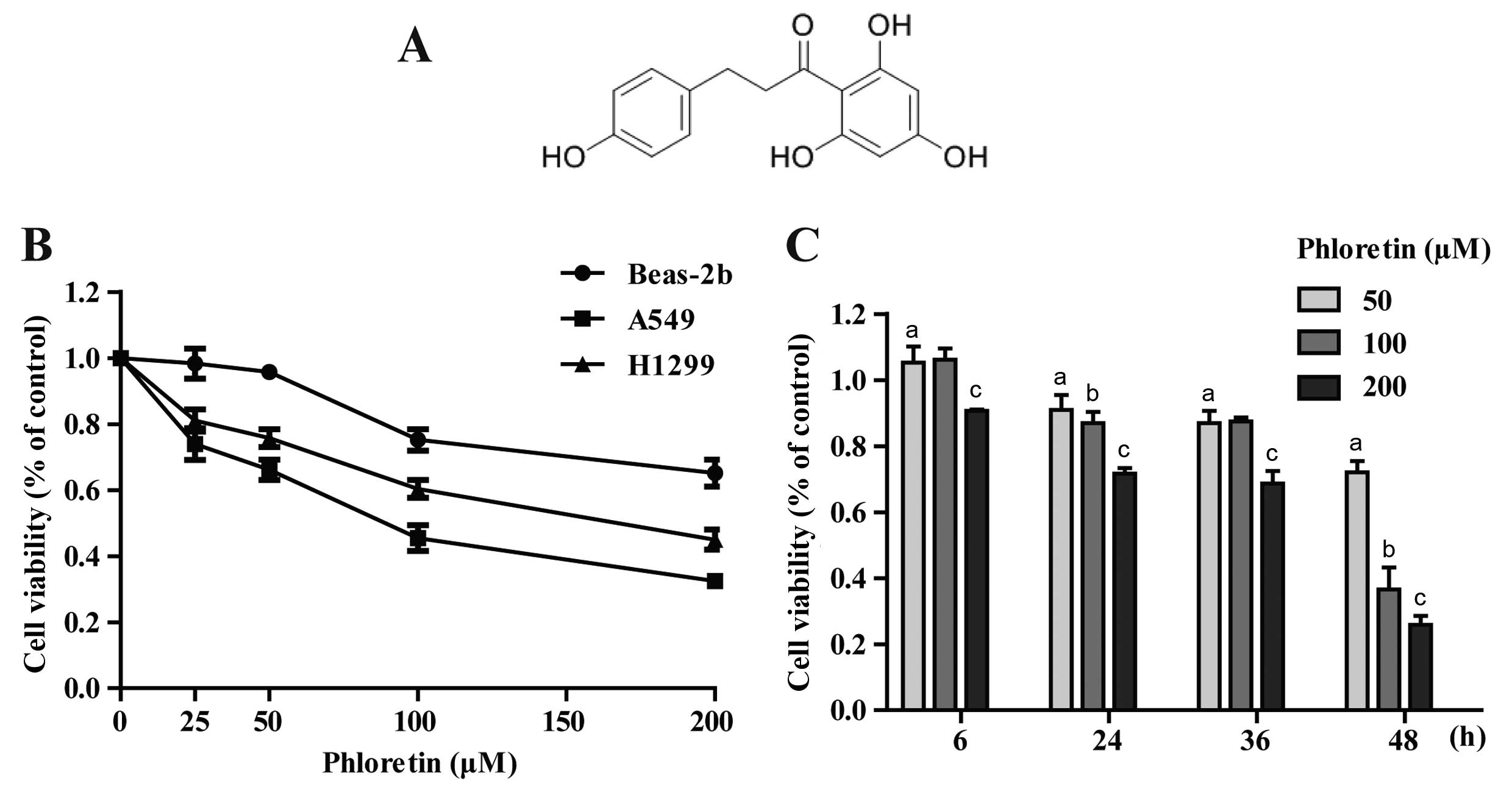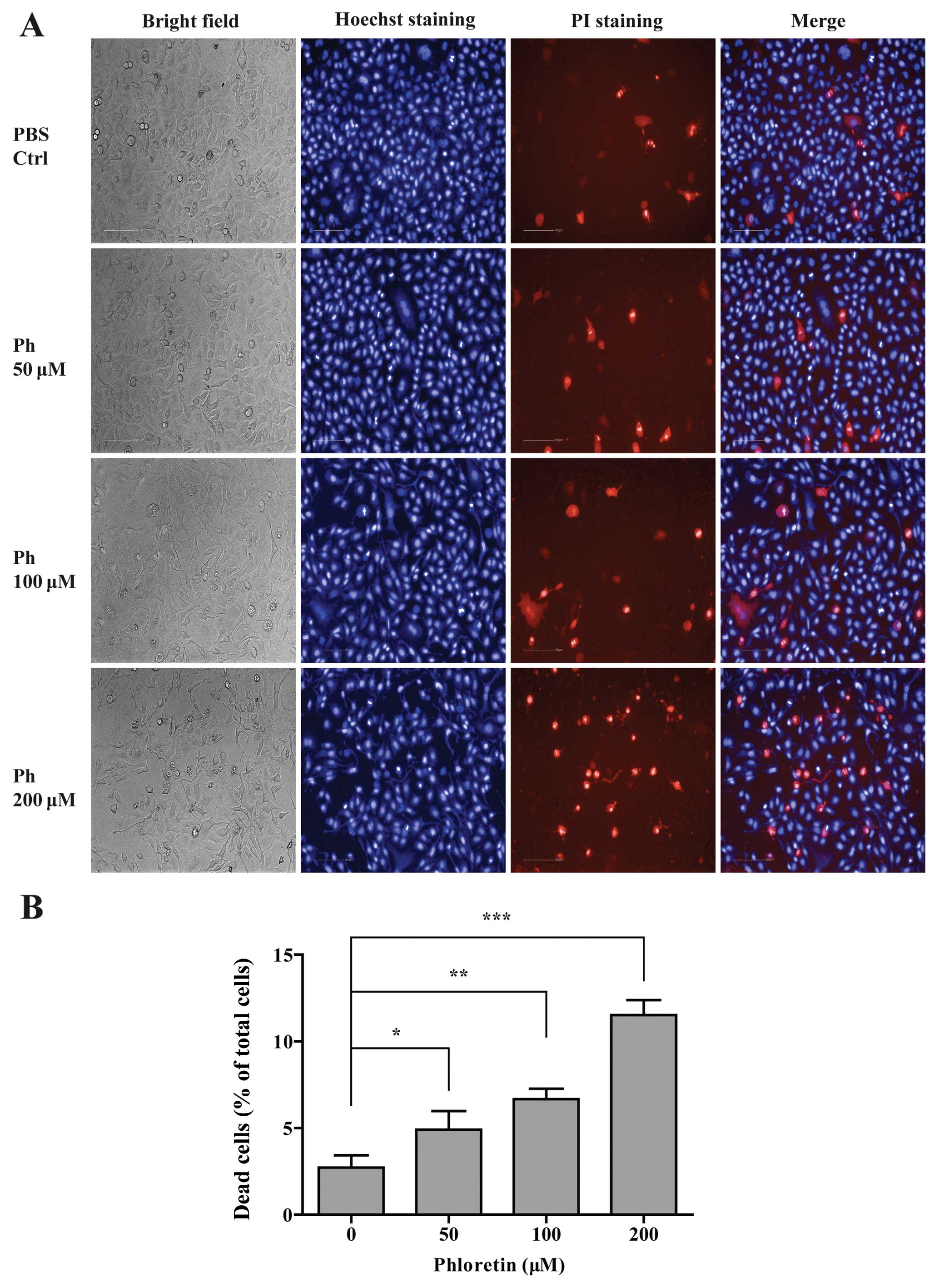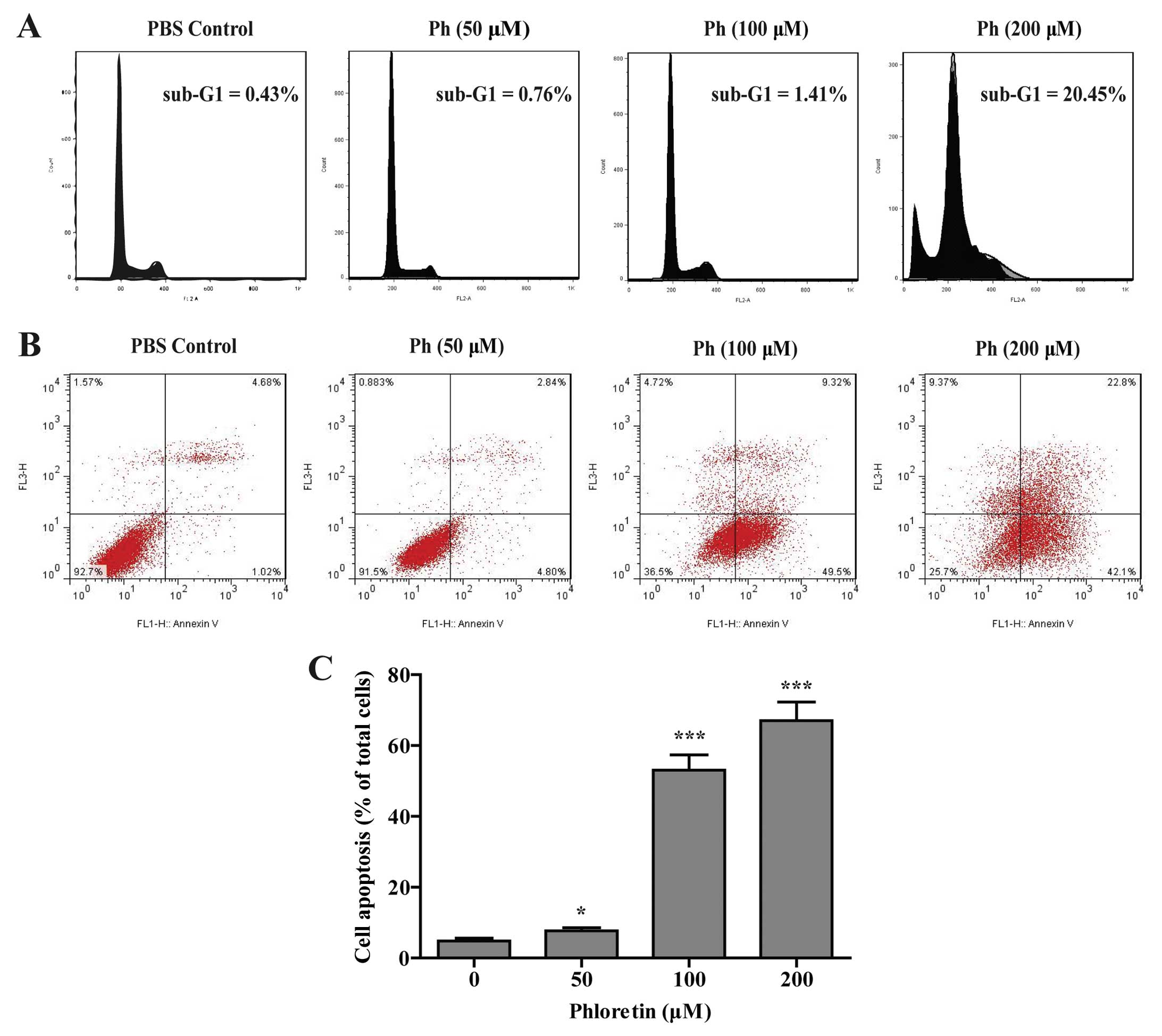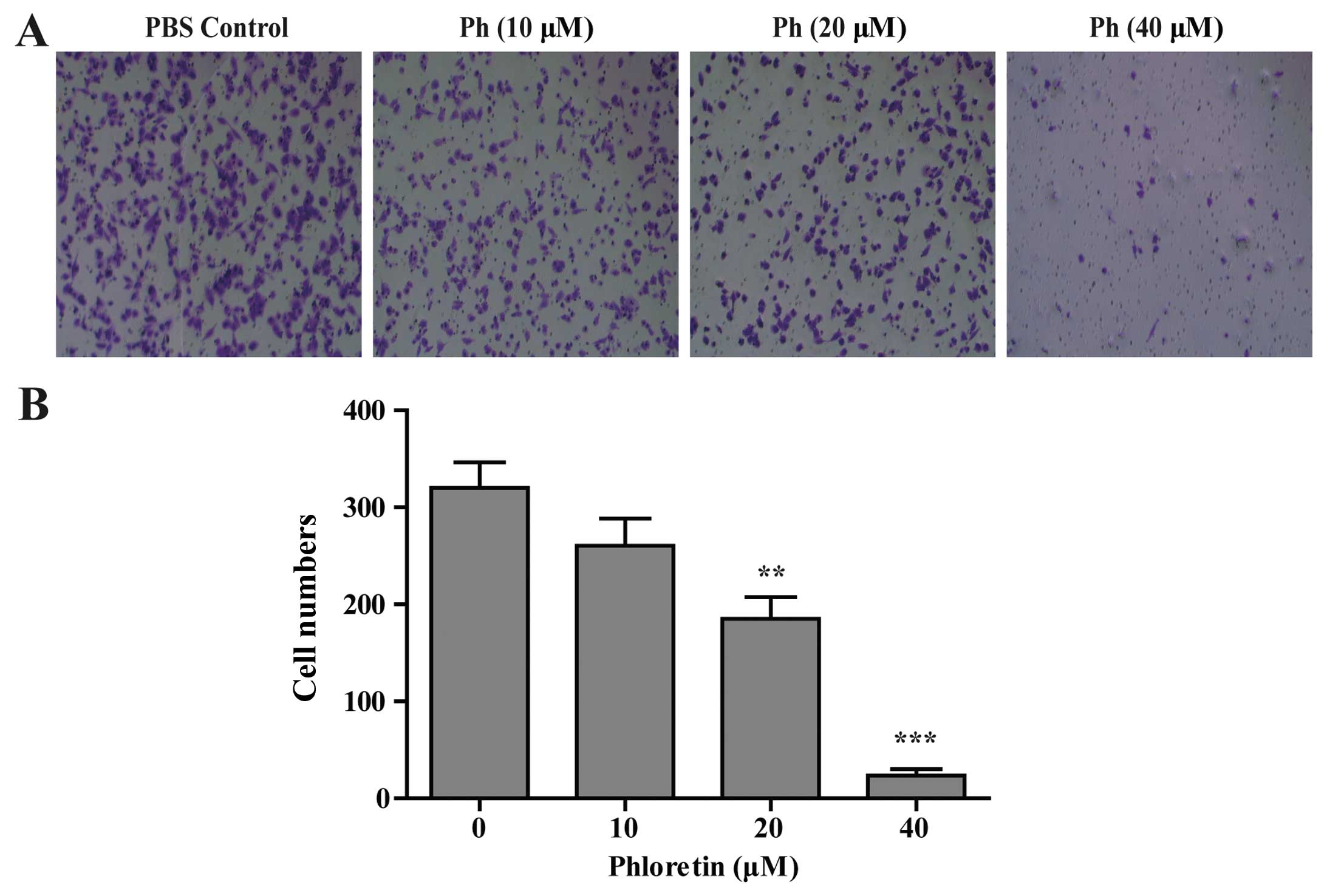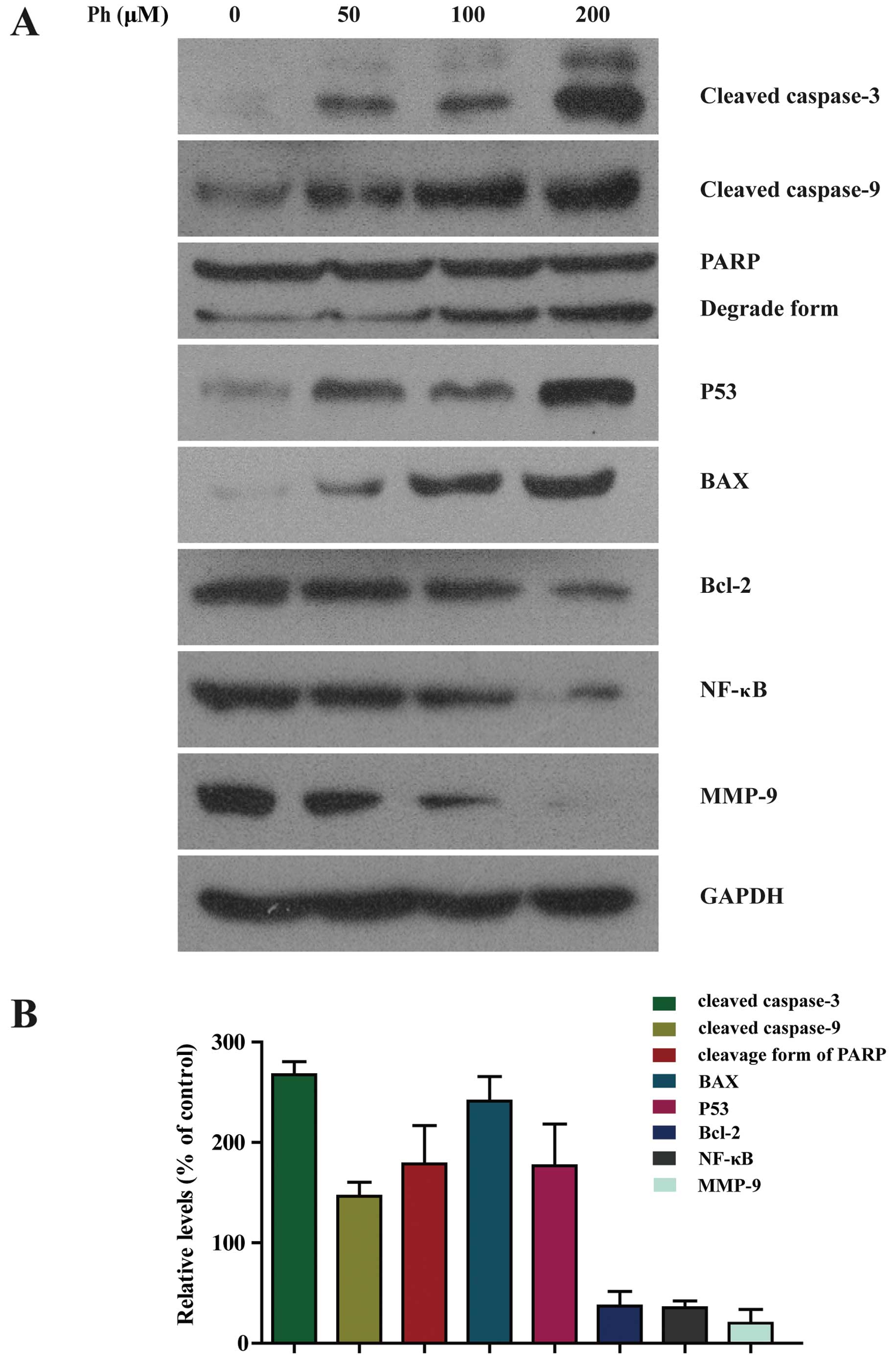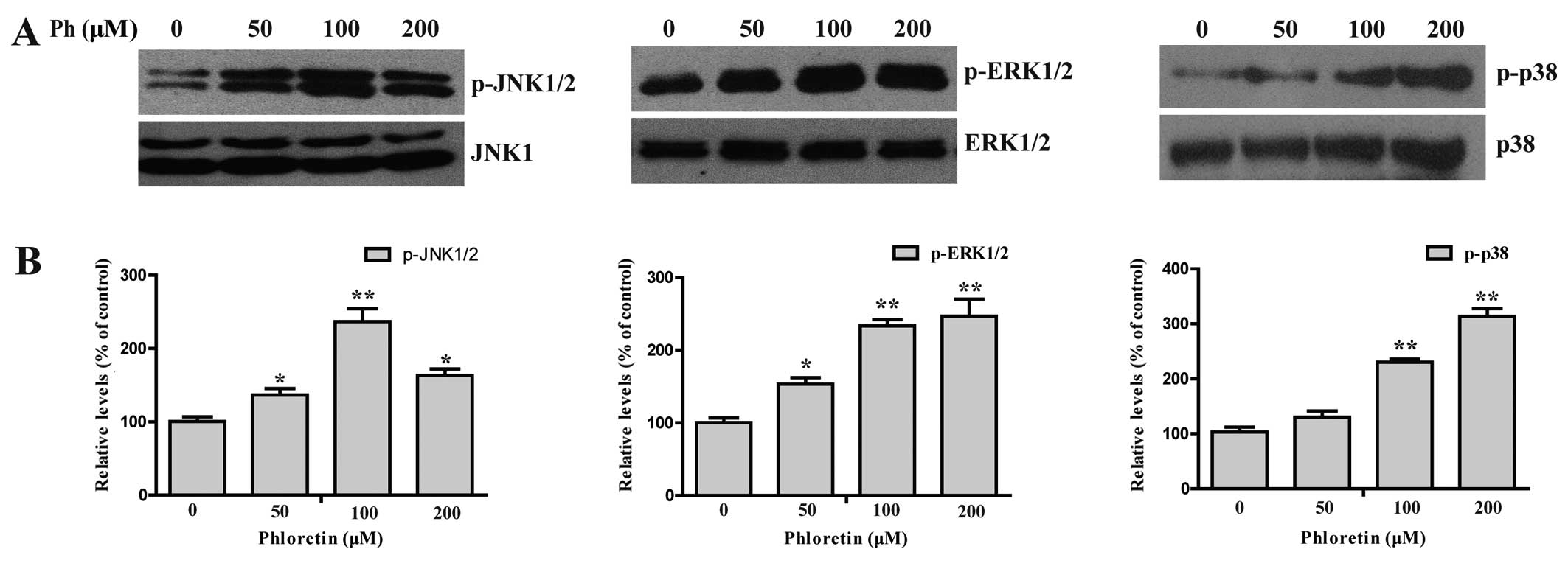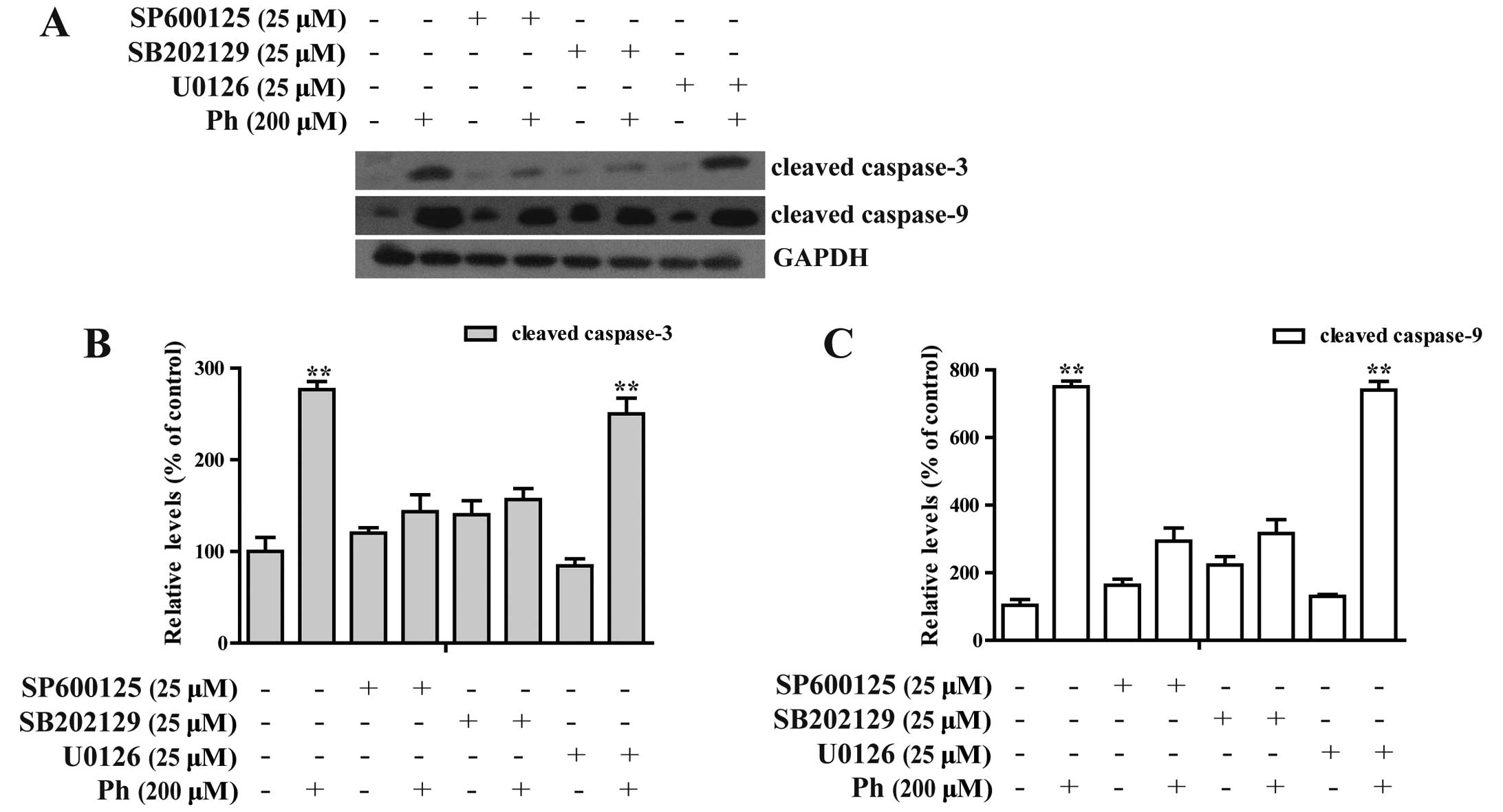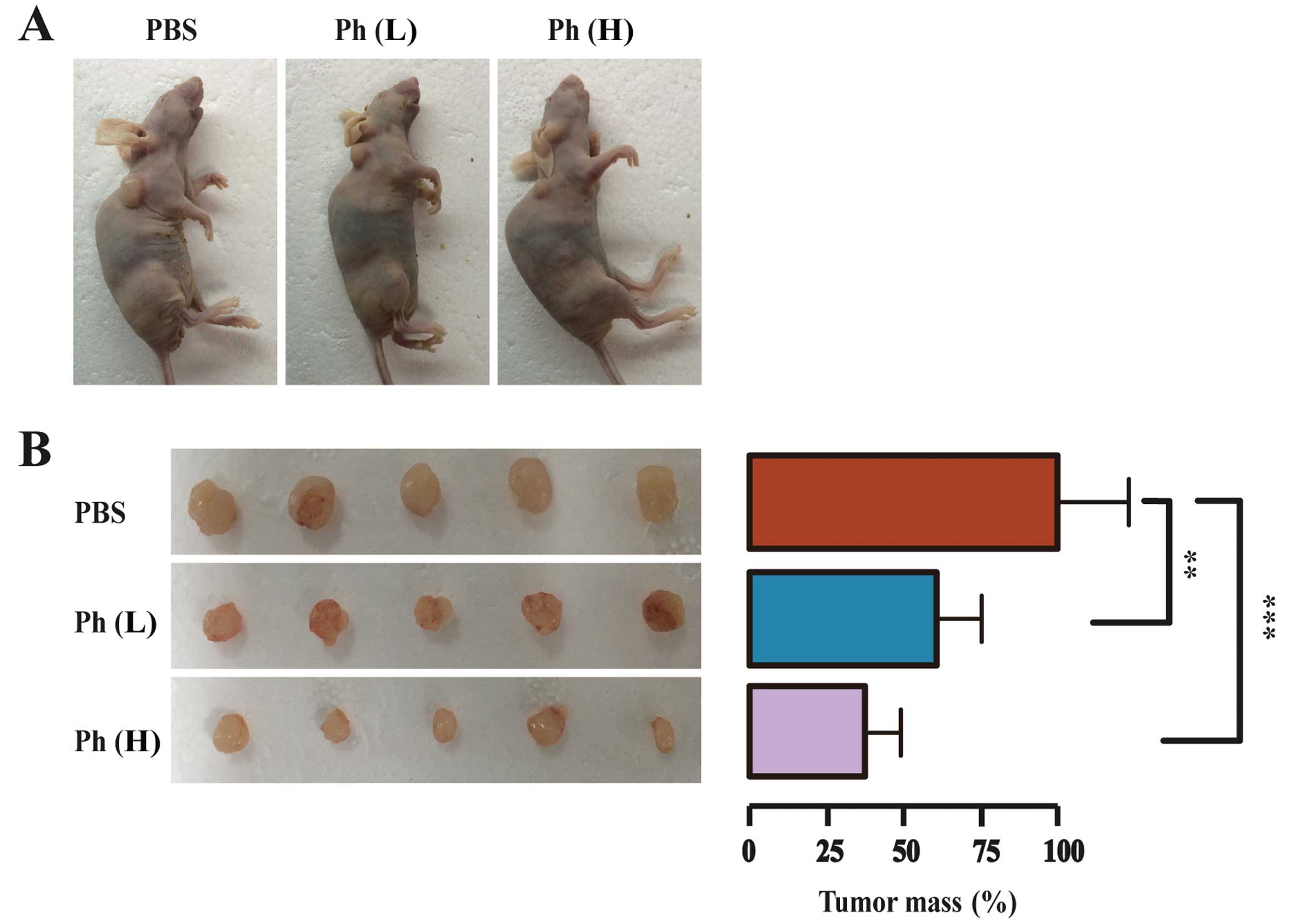Phloretin induces apoptosis of non-small cell lung carcinoma A549 cells via JNK1/2 and p38 MAPK pathways
- Authors:
- Published online on: October 2, 2015 https://doi.org/10.3892/or.2015.4325
- Pages: 2871-2879
-
Copyright: © Min et al. This is an open access article distributed under the terms of Creative Commons Attribution License.
Abstract
Introduction
Lung cancer is a major cause of morbidity and mortality worldwide and the most common cause of cancer-related death (1). Non-small cell lung cancer (NSCLC) accounts for ~85% of all lung cancers. Although surgical and chemotherapeutic treatments have made great contributions in lung cancer, these methods may induce serious long-term adverse effects. Various natural herbal products have gained increasing attention due to their potential anticancer effects against NSCLC (2,3).
Phloretin (Ph) (2′,4′,6′-trihydroxy-3-(4-hydroxyphenyl)-propiophenone) is a natural polyphenolic compound existing in apples, pears and other plants of the rosaceae family and has been found to have anti-inflammatory and immunosuppressive effects on both lymphoid- and myeloid-derived cell lines (4). Ph has also been shown to have antitumor activities by inducing apoptosis in human leukemia cells, bladder cancer and human colon cancer cells (5–7), and inhibiting the growth, invasiveness and migration of human liver cancer cells (8). However, little is known about its effects on human lung cancer cells.
In the present study, we investigated the possible anticancer effects of Ph on A549 lung adenocarcinoma cells in vitro and in vivo, and discussed the underlying molecular mechanisms. We demonstrated that Ph could inhibit A549 cell proliferation by inducing apoptosis, and that upregulation of JNK, ERK, Bax and P38 MAPK by Ph was associated with the downregulation of Bcl-2 and NF-κB, and the activation of caspase-3 and -9, and P53, suggesting that Ph may be a useful plant product for the treatment of lung cancer.
Materials and methods
Chemicals and reagents
Ph, 3-(4,5-dimethylthiazol-2-yl)-2,5-diphenyltetrazolium bromide (MTT) and dimethylsulfoxide (DMSO) were purchased from Sigma Chemical Co. Dulbecco's modified Eagle's medium (DMEM) and fetal bovine serum (FBS) were obtained from Life Technologies. FITC-Annexin V/PI apoptosis detection kit was purchased from BD Biosciences. Ph stock solution was prepared into 50, 100 and 200 µM concentrations in DMSO and stored at -20°C. The final concentration of DMSO for all treatments was consistently <0.1%. Specific inhibitors for JNK1/2 (SP600125), ERK1/2 (U0126) or P38 (SB202190) were purchased from Calbiochem. The following antibodies were used: JNK1, p-JNK1/2 (Cell Signaling), P53, cleaved caspase-3, caspase-9, NF-κB, MMP-9 (Santa Cruz), P38, p-P38, ERK1/2, p-ERK1/2, Bcl-2, Bax and PARP (Bioworld Technology), and GAPDH (Sigma).
Cell culture
Human NSCLC A549, H1299 and bronchial epithelial cells (Beas-2b) were from the Institute of Biochemistry and Cell Biology (Shanghai Institutes for Biological Sciences, CAS). Cells were maintained in DMEM supplemented with 10% FBS in a humidified incubator under 5% CO2 at 37°C.
In vitro cytotoxicity assay
MTT was performed as previously described (9). Cells were cultured into a 96-well plate (1×104/well), stimulated with different concentrations (0, 25, 50, 100 and 200 µM) of Ph in culture medium when the cells were 80–90% confluent. After 48 h Ph of stimulation, the medium was removed and 100 µl MTT was added to each well (0.5 mg/ml final concentration) for further incubation for 4 h. Then the medium was removed, and 100 µl DMSO was added to dissolve the solid formazan for 15 min. The absorbance of each well was read at 570 nm using a microplate reader (Thermo Fisher).
Fluorescence observation of cell death
A549 cells (6×103 cells/well) on 96-well plates were incubated with phosphate-buffered saline (PBS) control and Ph (50, 100 and 200 µM) for 24 h, then treated with Hoechst 33342 (10 mg/ml) for another 1 h, stained with propidium iodide (PI; 100 mg/ml) for 15 min (10), washed with PBS three times and observed on Operetta high content analysis system (Perkin-Elmer).
Annexin V/PI double staining
To detect apoptosis in A549 cells after exposure to Ph, the FITC-Annexin V apoptosis detection kit was used to quantify the number of cells in different stages of cell death. Briefly, A549 cells seeded into 6-well plates, and treated with PBS control and Ph (50, 100 and 200 µM) for 48 h. Then, 1×105 cells were re-suspended in 100 µl 1X binding buffer. After addition of FITC-Annexin V and PI (5 µl each), the cell suspension was gently vortexed and incubated for 20 min at room temperature in the dark. After addition of 400 µl 1X binding buffer to each tube, cells were analyzed by flow cytometry (BD Calibur).
Cell cycle analysis
To determine the effect of Ph on the cell cycle, A549 cells were seeded into 6-well plates, treated with PBS control and Ph (50, 100 and 200 µM) for 48 h, fixed with 70% ethanol at 4°C for 30 min, and then incubated for another 30 min in the dark, at room temperature with PI buffer [50 mg/ml containing ribonuclease A (50 ng/ml)]. Cell cycle distribution was analyzed for 10,000 collected cells with Aria II flow cytometer (BD Biosciences).
Transwell migration assay
The effect of Ph on migration of A549 cells was further analyzed using Transwell chambers with 8-mm porous membrane (Corning, Corning, NY, USA). Cells were treated with PBS control and different concentrations (10, 20 and 40 µM) of Ph for 24 h, and then loaded into the migration chamber at 1×105. Medium containing 10% FBS was placed in the lower chambers. After allowing cell migration for 6 h, cells were removed from the upper side of the membrane; migratory cells on the lower side of the membrane were fixed with 4% paraformaldehyde for 20 min, and then washed with PBS three times before being stained with crystal violet for another 10 min (11). The number of migratory cells was counted by fluorescence microscopy (magnification, ×100).
Western blotting
A549 cells were seeded into 6-well plates and incubated with PBS control and different concentrations (50, 100 and 200 µM) of Ph for 48 h, lysed in RIPA buffer (50 mM Tris-HCl, pH 7.2, 150 mM NaCl, 1% NP40, 0.1% SDS, 0.5% DOC, 1 mM PMSF, 25 mM MgCl2, supplemented with a phosphatase inhibitor cocktail) and finally subjected to immunoblotting analysis with indicated antibodies. GAPDH were diluted to 1:2,000, P53, cleaved caspase-3 and -9, NF-κB, MMP-9 were diluted to 1:200; and JNK1, p-JNK1/2, P38, p-P38, ERK1/2, p-ERK1/2, Bcl-2, Bax and PARP were diluted to 1:1,000.
In vivo antitumor effect
Female nude mice (BK Biotech) aged 5 weeks were used. A549 cells (5×106) were suspended in Matrigel (BD Biosciences) and injected subcutaneously (s.c.) into the mice. All animal procedures were performed following the protocol approved by the Institutional Animal Care Committee of Shanghai Institute of Biochemistry and Cell Biology (Shanghai, China). Mice bearing evident tumors were randomly divided into PBS control group, low-dose (10 mg/kg) Ph group, and high-dose (20 mg/kg) Ph group. Ph was dissolved in PBS for intraperitoneal (i.p.) administration to the mice every two days for three weeks. Animals were euthanized with carbon dioxide. Tumor masses were isolated and tumor weight was measured as previously described (12).
Statistical analysis
Results are expressed as mean ± SD (range) or percentage. The difference between two groups was analyzed using the Student's t-test. Statistical analyses were performed using the one-way analysis of variance (ANOVA) followed by Tukey's post hoc test when more than three groups were analyzed. A P-value <0.05 was considered to indicate a statistically significant result. The differentiation of amount of protein expressions were calculated using Image Lab version 4.0 software (Bio-Rad Laboratories, Inc.). All calculations were performed using GraphPad Prism software (GraphPad Software, San Diego, CA, USA).
Results
Cytotoxic effects of Ph-treated A549 and H1299 cells
The chemical structure of Ph is shown in Fig. 1A (13). The cytotoxicity comparison of Ph on A549, H1299 and Beas-2b cells was evaluated. After cells were treated with different concentrations (0, 25, 50, 100 and 200 µM) of Ph for 48 h, Ph exhibited a moderate effect on normal human Beas-2b cells, and Ph had more cytotoxic effects on A549 than H1299 cells (Fig. 1B). Furthermore, A549 cancer cells were dose- and time-dependently observed when the cells were treated with Ph for 6, 24, 36 and 48 h (Fig. 1C).
Ph-induced cell death in A549 cells
To further compare the cytotoxicity between different concentrations of Ph on A549 cells, cell death assay was performed on Operetta high content analysis system. A549 cells were incubated with PBS control and different concentrations (50, 100 and 200 µM) of Ph for 24 h, and then double stained with Hoechst 33342 (blue indicates the nucleus) and PI (red indicates dead cells). As shown in Fig. 2, Ph significantly increased the cell death rate in a dose-dependent manner, and A549 cells became more curved and thinner with the concentration of Ph increasing.
Ph-induced cell apoptosis in A549 cells
To determine whether the inhibitory effect of Ph on cell viability was associated with the induction of cell apoptosis, A549 cells were treated with different concentrations (0, 50, 100 and 200 µM) of Ph for 24 h. As shown in Fig. 3A, in PBS control group, the percentage of cells in the sub-G1 fraction was low (0.43%), and a significant proportion of cells (20.45%) went into sub-G1 phase when treated with Ph at 200 µM. Apoptotic cells with a lower DNA content should fall into similar sub-G1 region in cell cycle on flow cytometric analysis (10). Cell cycle analysis by flow cytometry showed a dose-dependent increased accumulation of cell population in sub-G1 phase. Annexin V and PI double staining displayed an increased percentage of apoptotic cells and dead cells after Ph treatment for 24 h (Fig. 3B and C). These results suggest that the strong effect of Ph on A549 cells may be due to induction of more apoptosis with the increased concentration.
Effect of Ph on A549 cell migration
The potential function of Ph on A549 tumor cell migration was characterized by Transwell migration assay. Cells were treated with indicated concentrations of Ph for 24 h, and loaded into the migration chamber at 1×105. The results showed that Ph treatment slowed down the migration of A549 cells in a concentration-dependent manner. As shown in Fig. 4, 40 µM Ph markedly inhibited the migration of A549 cells.
Ph induces activation of caspase-3 and -9 in A549 cells
To further investigate whether caspase activation was involved in Ph-induced apoptosis, activation of caspase-3 and -9 and PARP was detected. As shown in Fig. 5A, exposure of A549 cells to Ph (0, 50, 100 and 200 µM) for 24 h increased the number of cleaved fragments of caspase-3 and -9 in a dose-dependent manner. It is known that PARP is a characteristic marker of apoptosis (14), the abundance of the cleaved form of PARP was increased compared to the control. Ph treatment at 200 µM for 24 h increased the expression level of cleaved caspase-3 and -9 and cleavage form of PARP by 2.6-, 1.3- and 1.5-fold compared to the control, respectively. Ph decreased Bcl-2 and NF-κB, and increased the expression level of P53 and Bax in a dose-dependent manner. As shown in Fig. 5B, compared to the control, Ph treatment at 200 µM for 24 h significantly increased the expression level of P53 and Bax by 1.8- and 2.3-fold, respectively, and decreased the expression level of Bcl-2 and NF-κB by 34 and 32%, respectively. These data suggest that caspase-3, and -9, PARP, Bcl-2, Bax, NF-κB and P53 were involved in Ph-induced apoptosis. MMPs can degrade the basement membrane and play main roles in promotion of cancer invasion and metastasis (15). As anticipated, we also found that the expression level of MMP-9 was decreased in Ph-treated A549 cells by 22%, which is consistent with previous data from the migration assay (Fig. 4A).
Ph-induced apoptosis is involved in the regulation of P38 MAPK and JNK signaling pathways in A549 cells
MAPK signaling pathway plays an important role in the action of chemotherapeutic drugs in the regulation of apoptosis (16–18). To see whether MAPKs were involved in Ph-induced apoptosis, we first examined the activation status of JNK, ERK and P38 by western blotting with antibodies specific to the phosphorylated forms of these kinases. As shown in Fig. 6, treatment of cells with (0, 50, 100 and 200 µM) Ph increased the phosphorylated form of JNK, ERK and P38 in a dose-dependent manner, with the total protein levels remaining steady, indicating the activation of JNK, ERK and P38 in A549 cells. In contrast, A549 cells were pretreated with 25 µM SP600125 (a JNK inhibitor), U0126 (an ERK inhibitor) or SB202190 (a P38 inhibitor) for 45 min, treated with 200 µM Ph for another 24 h, and then cleaved caspase-3 and -9 were analyzed by western blotting. SP600125 and SB202190 treatment significantly attenuated Ph-induced caspase-3 and -9 activation, as shown in Fig. 7. These findings suggest that activation of JNK1/2 and P38 MAPK may play a crucial upstream role in Ph-mediated caspase activation in A549 cells.
Antitumor activity of Ph on A549 lung tumor xenografts
To further evaluate the tumor-suppressing effect of Ph in vivo, a model for tumorigenicity of A549 cancer cells in nude mice was established. A549 cells (5×106 cells) were injected s.c. into the female nude mice aged 5 weeks and weighing ~20 g. After three days, 15 mice bearing visible tumors were equally randomized to a PBS control, a low-dose (10 mg/kg) Ph group, and a high-dose (20 mg/kg) Ph group. Ph was dispersed in PBS and administered i.p. every two days for three weeks. After three weeks, mice were sacrificed and tumors were dissected and weighed. Tumor images and mean tumor weight in each group are shown in Fig. 8. As anticipated, the tumor size was decreased significantly in both Ph groups, compared to that in the control group. The mean tumor mass in low- and high-dose Ph groups was ~61 and 38% of that in the control group respectively, indicating that Ph had an inhibitory effect on lung carcinoma xenograft growth in mice.
Discussion
Lung cancer is the most commonly diagnosed cancer and one of the leading causes of cancer death in males, and was the 4th most commonly diagnosed cancer and the 2nd leading cause of cancer-related death in females in 2008 worldwide. Lung cancer accounted for 13% (1.6 million) of the total cases and 18% (1.4 million) of cancer deaths in 2008 (19,20). How to enhance antitumor function and expand survival in lung cancer patients has been an open question for decades. Apoptosis (programmed cell death), is not only essential to the development and maintenance of homeostasis during cell growth but plays an important role in the prevention of tumor development (21,22). Natural herbal products are currently studied for their antitumor activities including apoptosis induction and antiproliferative activities (23–25). However, their active components and molecular mechanisms of action are not well understood. Ph is a natural phenol existing in apples and a variety of vegetables (26,27). Ph has been previously reported with anticancer effects on breast and hepatocellular cancer and colon cancer cell lines (5,12,28). The present study for the first time demonstrated that Ph induced apoptosis and inhibit migration of NSCLC A549 cells.
During the apoptotic process, pro-apoptotic Bcl-2 members such as BAX redistribute from the cytosol to mitochondria, resulting in increased membrane permeability. Induction of BAX results in a downstream program of mitochondrial dysfunction and activation of caspases. Due to this event, the released mitochondrial cytochrome participates in this process, leading to caspase-9 activation and subsequent activation of caspase-3 (29), thus increasing the cleavage form of PARP and inducing A549 cell apoptosis. It was found in the present study that the expression of BAX and fractured PARP protein was increased, the expression of Bcl-2 was decreased, and caspase-3 and -9 were activated in a dose-dependent manner after Ph treatment. In addition, protein MMP-9 was inhibited after Ph treatment, particularly in the 200 µM group. These findings are consistent with the results of cell apoptosis assay and migration assay in the previous experiments. These results proved that Ph not only induced mitochondrial activation-mediated apoptotic cell death but inhibited migration of A549 cells.
Previous studies have suggested that MAPKs can be induced by various compounds and are involved in cell death in NSCLC A549 cells (30,31). The MAPK family includes three kinase members, including c-Jun NH2-terminal protein kinase/stress activated protein kinases (JNK/SAPKs), P38 MAPK, and extracellular signal-regulated kinase (ERK). Previous results tempted us to ask whether the tumor-suppressing effect of Ph relied on the presence of the P38 MAPK signaling system in A549 cells. To answer this question, we further investigated activation of the MAPK family proteins in Ph-treated A549 cells. The results showed that the phosphorylation of ERK1/2, JNK1/2 and P38 MAPK was increased in Ph-treatment A549 cells in a dose-dependent manner with the total protein level remaining steady. However, treatment with JNK1/2 specific inhibitor (SP600125) or the P38 MAPK specific inhibitor (SB202190) effectively inhibited activation of caspase-3 and caspase-9 induced by Ph, whereas U0126 (an ERK1/2 inhibitor) showed no effect on Ph-induced caspase activation. These findings suggest that activation of JNK1/2 and P38 MAPK plays a critical role in Ph-induced apoptosis in NSCLC A549 cells.
Acknowledgments
This study was supported by the Key Program of the Shanghai Committee of Science and Technology (no. 12JC1410901) and the National Natural Science Funds of China (no. 81402449).
References
|
Ferlay J, Shin HR, Bray F, Forman D, Mathers C and Parkin DM: Estimates of worldwide burden of cancer in 2008: GLOBOCAN 2008. Int J Cancer. 127:2893–2917. 2010. View Article : Google Scholar | |
|
Shankar S, Ganapathy S, Hingorani SR and Srivastava RK: EGCG inhibits growth, invasion, angiogenesis and metastasis of pancreatic cancer. Front Biosci. 13:440–452. 2008. View Article : Google Scholar | |
|
Boyer J and Liu RH: Apple phytochemicals and their health benefits. Nutr J. 3:52004. View Article : Google Scholar : PubMed/NCBI | |
|
Fordham JB, Naqvi AR and Nares S: Leukocyte production of inflammatory mediators is inhibited by the antioxidants phloretin, silymarin, hesperetin, and resveratrol. Mediators Inflamm. 2014:9387122014. View Article : Google Scholar : PubMed/NCBI | |
|
Zhu SP, Liu G, Wu XT, Chen FX, Liu JQ, Zhou ZH, Zhang JF and Fei SJ: The effect of phloretin on human γδ T cells killing colon cancer SW-1116 cells. Int Immunopharmacol. 15:6–14. 2013. View Article : Google Scholar | |
|
Devi MA and Das NP: In vitro effects of natural plant polyphenols on the proliferation of normal and abnormal human lymphocytes and their secretions of interleukin-2. Cancer. 69:191–196. 1993. | |
|
Nelson JA and Falk RE: The efficacy of phloridzin and phloretin on tumor cell growth. Anticancer Res. 13:2287–2292. 1993.PubMed/NCBI | |
|
Yang KC, Tsai CY, Wang YJ, Wei PL, Lee CH, Chen JH, Wu CH and Ho YS: Apple polyphenol phloretin potentiates the anticancer actions of paclitaxel through induction of apoptosis in human hep G2 cells. Mol Carcinog. 48:420–431. 2009. View Article : Google Scholar | |
|
Zare Jahromi M, Ranjbarian P and Shiravi S: Cytotoxicity evaluation of Iranian propolis and calcium hydroxide on dental pulp fibroblasts. J Dent Res Dent Clin Dent Prospects. 8:130–133. 2014.PubMed/NCBI | |
|
Shen J, Song G, An M, Li X, Wu N, Ruan K, Hu J and Hu R: The use of hollow mesoporous silica nanospheres to encapsulate bortezomib and improve efficacy for non-small cell lung cancer therapy. Biomaterials. 35:316–326. 2014. View Article : Google Scholar | |
|
Zuo Y, Yang J, He J, Zhao Y and He Y: An uncoordinated-5 homolog B receptor monoclonal antibody regulates A375 melanoma cell migration. Monoclon Antib Immunodiagn Immunother. 33:280–286. 2014. View Article : Google Scholar : PubMed/NCBI | |
|
Wu CH, Ho YS, Tsai CY, Wang YJ, Tseng H, Wei PL, Lee CH, Liu RS and Lin SY: In vitro and in vivo study of phloretin-induced apoptosis in human liver cancer cells involving inhibition of type II glucose transporter. Int J Cancer. 124:2210–2219. 2009. View Article : Google Scholar : PubMed/NCBI | |
|
Shao X, Bai N, He K, Ho CT, Yang CS and Sang S: Apple polyphenols, phloretin and phloridzin: New trapping agents of reactive dicarbonyl species. Chem Res Toxicol. 21:2042–2050. 2008. View Article : Google Scholar : PubMed/NCBI | |
|
Diefenbach J and Bürkle A: Introduction to poly(ADP-ribose) metabolism. Cell Mol Life Sci. 62:721–730. 2005. View Article : Google Scholar : PubMed/NCBI | |
|
Björklund M and Koivunen E: Gelatinase-mediated migration and invasion of cancer cells. Biochim Biophys Acta 2005. 1755:37–69. 2005. | |
|
Dong ZH, Wang DC, Liu TT, Li FH, Liu RL, Wei JW and Zhou CL: The roles of MAPKs in rabbit nucleus pulposus cell apoptosis induced by high osmolality. Eur Rev Med Pharmacol Sci. 18:2835–2845. 2014.PubMed/NCBI | |
|
Han R, Liang H, Qin ZH and Liu CY: Crotoxin induces apoptosis and autophagy in human lung carcinoma cells in vitro via activation of the P38 MAPK signaling pathway. Acta Pharmacol Sin. 35:1323–1332. 2014. View Article : Google Scholar : PubMed/NCBI | |
|
Palanivel K, Kanimozhi V and Kadalmani B: Verrucarin A alters cell-cycle regulatory proteins and induces apoptosis through reactive oxygen species-dependent P38 MAPK activation in the human breast cancer cell line MCF-7. Tumour Biol. 35:10159–10167. 2014. View Article : Google Scholar : PubMed/NCBI | |
|
Jemal A, Bray F, Center MM, Ferlay J, Ward E and Forman D: Global cancer statistics. CA Cancer J Clin. 61:69–90. 2011. View Article : Google Scholar : PubMed/NCBI | |
|
Jemal A, Center MM, DeSantis C and Ward EM: Global patterns of cancer incidence and mortality rates and trends. Cancer Epidemiol Biomarkers Prev. 19:1893–1907. 2010. View Article : Google Scholar : PubMed/NCBI | |
|
Woodle ES and Kulkarni S: Programmed cell death. Transplantation. 66:681–691. 1998. View Article : Google Scholar : PubMed/NCBI | |
|
Bobba A, Amadoro G, La Piana G, Calissano P and Atlante A: Glycolytic enzyme upregulation and numbness of mitochondrial activity characterize the early phase of apoptosis in cerebellar granule cells. Apoptosis. 20:10–28. 2015. View Article : Google Scholar | |
|
Schwingel TE, Klein CP, Nicoletti NF, Dora CL, Hadrich G, Bica CG, Lopes TG, da Silva VD and Morrone FB: Effects of the compounds resveratrol, rutin, quercetin, and quercetin nanoemulsion on oxaliplatin-induced hepatotoxicity and neurotoxicity in mice. Naunyn Schmiedebergs Arch Pharmacol. 387:837–848. 2014. View Article : Google Scholar : PubMed/NCBI | |
|
Hong JY, Park SH, Min HY, Park HJ and Lee SK: Anti-proliferative effects of evodiamine in human lung cancer cells. J Cancer Prev. 19:7–13. 2014. View Article : Google Scholar : PubMed/NCBI | |
|
Zhao B and Hu M: Gallic acid reduces cell viability, proliferation, invasion and angiogenesis in human cervical cancer cells. Oncol Lett. 6:1749–1755. 2013. | |
|
Wang L, Li ZW, Zhang W, Xu R, Gao F, Liu YF and Li YJ: Synthesis, crystal structure, and biological evaluation of a series of phloretin derivatives. Molecules. 19:16447–16457. 2014. View Article : Google Scholar : PubMed/NCBI | |
|
Chang WT, Huang WC and Liou CJ: Evaluation of the anti-inflammatory effects of phloretin and phlorizin in lipopolysaccharide-stimulated mouse macrophages. Food Chem. 134:972–979. 2012. View Article : Google Scholar : PubMed/NCBI | |
|
Kim MS, Kwon JY, Kang NJ, Lee KW and Lee HJ: Phloretin induces apoptosis in H-Ras MCF10A human breast tumor cells through the activation of p53 via JNK and p38 mitogen-activated protein kinase signaling. Ann N Y Acad Sci. 1171:479–483. 2009. View Article : Google Scholar : PubMed/NCBI | |
|
Gross A, Jockel J, Wei MC and Korsmeyer SJ: Enforced dimerization of BAX results in its translocation, mitochondrial dysfunction and apoptosis. EMBO J. 17:3878–3885. 1998. View Article : Google Scholar : PubMed/NCBI | |
|
Park WH and Kim SH: MAPK inhibitors augment gallic acid-induced A549 lung cancer cell death through the enhancement of glutathione depletion. Oncol Rep. 30:513–519. 2013.PubMed/NCBI | |
|
Hsiao YC, Kuo WH, Chen PN, Chang HR, Lin TH, Yang WE, Hsieh YS and Chu SC: Flavanone and 2′-OH flavanone inhibit metastasis of lung cancer cells via down-regulation of proteinase activities and MAPK pathway. Chem Biol Interact. 167:193–06. 2007. View Article : Google Scholar : PubMed/NCBI |



